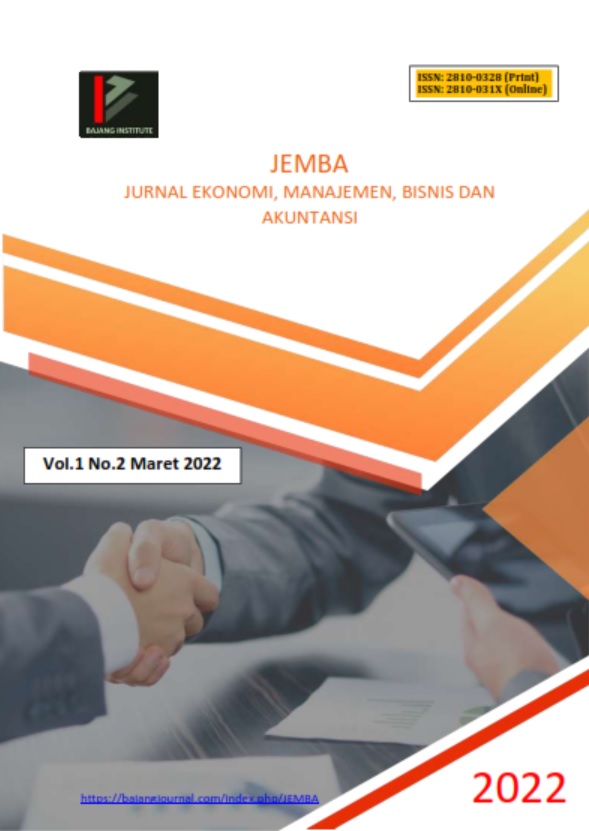STRATEGI PENGEMBANGAN USAHA ‘DIKA BAN KALASAN’ DENGAN PENDEKATAN MATRIKS SPACE (PENDEKATAN STUDI KASUS)
DOI:
https://doi.org/10.53625/jemba.v1i2.1946Keywords:
SWOT Analysis, EFAS, IFAS, Space MatrixAbstract
This study aims to analyze the internal and external factors of the motorcycle workshop ‘Dika Ban Kalasan’ using a space matrix approach. The type of research used is descriptive with a qualitative approach. The type of data used is qualitative data. Sources of data used are primary data and secondary data. The data collection procedure used interviews and documentation. The data analysis used is descriptive method, while the data validity test uses source triangulation. The analysis technique uses the Space Matrix approach which is used to evaluate and sharpen the strategic position by providing a rating or weighting for each factor. The results of this study indicate that the motorcycle repair shop ‘Dika Ban Kalasan’ is in quadrant I. On the Cartesian Space Matrix chart where strength is greater than weakness, and opportunity is greater than threats. Based on the SWOT analysis, the strategy that can be applied to the motorcycle repair shop ‘Dika Ban Kalasan’ is a strategy that supports being aggressive. The strategy that supports the aggressive policy at the motorcycle repair shop "Dika Ban Kalasan" is the Intensive and Market Penetration strategy, as well as three alternative SO strategies (Strength, Opportunities).
References
Baroto, T. d. (2014). Analisis Strategi Pengembangan Bisnis PPOB KIPO Menggunakan Analisis SWOT dan QSPM. Jurnal Teknik Industri, Vol 15 No 1.
David, F. R. (2011). Manajemen Strategis Konsep. Jakarta: Salemba Empat.
David, F. R. (2014). Analisis SWOT Teknik Membedah Kasus Bisnis. Jakarta: PT. Gramedia Pustaka Utama.
Ebert, R. J. (2015). Pengantar Bisnis. Jakarta: Erlangga.
Edy, Y. (2016). Manajemen Strategi: Konsep. Yogyakarta: Andi.
Freddy, R. (2017). Analisis SWOT Teknik Membedah Kasus Bisnis. Jakarta: PT. Gramedia Pustaka.
Jauch, L. R. (1998). Manajemen Strategis dan Kebijakan Perusahaan. Jakarta: Erlangga.
Jr., A. P. (2013). Manajemen Strategis : Formulasi, Implementasi dan Pengendalian. Jakarta: Salemba Empat.
Kotler, P. d. (2012). Marketing management. Essex: Pearson Education Inc. Yogyakarta: Andi.
Kuncoro, M. (2006). Ekonomi Pembangunan. Jakarta: Salemba Empat.
Pasolog, h. (2011). Teori Administrasi Publik. Bandung: Alfabeta.
Porter, M. E. (2012). Competitve Strategy (Strategi Bersaing). Jakarta: Erlangga.
Setiawan, A. (2011). Analisis Pengaruh Rotasi Pekerjaan Terhadap Kinerja Karyawan Dengan Motivasi Kerja Sebagai Variabel Inervening. Jurnal Bisnis Strategi, Vol 20, No 1
Sugiyono. (2015). Metode Penelitian Kombinasi (Mix Method). Bandung: Alfabeta.
Suryana. (2009). Kewirausahaan. Jakarta: Salemba Empat.
Suwarsono, M. (2013). Manajemen Strategi : Konsep dan Alat Analisis. Yogyakarta: Akademi Manajemen Perusahaan YKPN.
Thomas, S. (2013). Linking Customеr Loyalty to Costumеr Satisfaction and Storе Imagе: a Structural Modеl for Rеtail Storеs. india: India Institute of Management Calcutta.
Umar, H. (2008). Aspek Internal Perusahaan. jakarta: PT. Gramedia Pustaka Utama.
Wheelen, H. J. (2008). Manajemen Strategis. Yogyakarta: Andi.
William. (2001). Ekonomi Mikro. Jakarta: Raja Grafindo.












